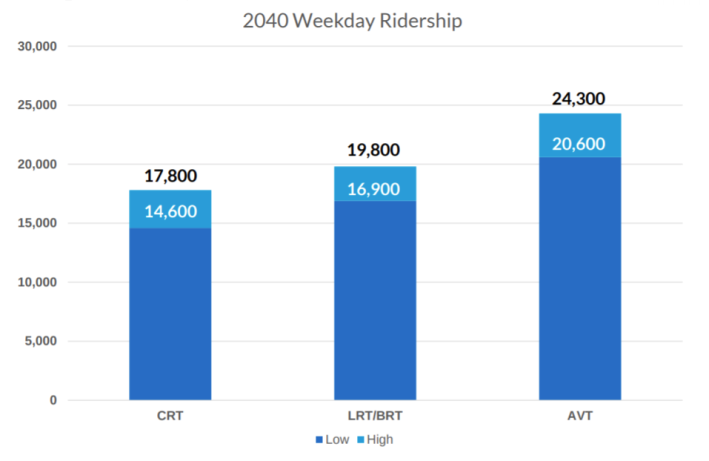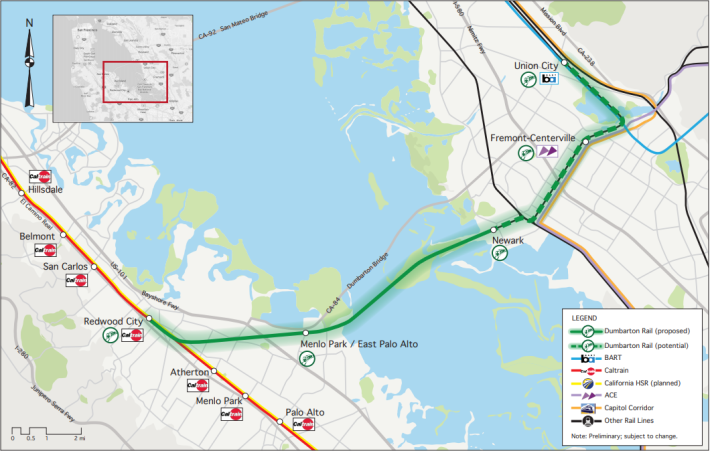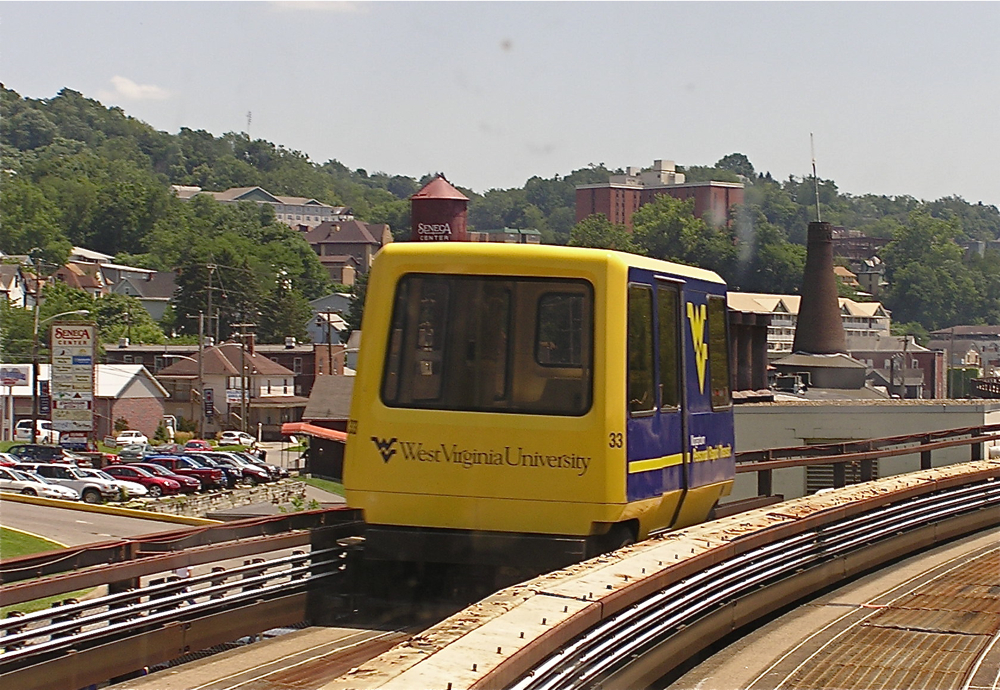What carries more people? A commuter train with as many as 1,000 seats or a futuristic Autonomous Vehicle Transit (AVT) pod with eight? If one is to believe the newest study of the Dumbarton Rail Corridor, presented to the public this week, it's the pod.
As shown in the chart below, the study authors claim their pod/AVT Tech, if used on the corridor, would carry a maximum of 24,300 passengers per weekday. But conventional commuter trains would carry only 17,800.

As Streetsblog readers are no doubt aware, the Dumbarton Rail Corridor is a defunct but mostly intact right-of-way that connects Caltrain's mainline around Redwood City to the East Bay Amtrak and ACE commuter rail tracks. For decades, there have been on-again, off-again efforts to re-activate this corridor to allow an integrated, cross-bay, Mid-Peninsula rail service by repairing or replacing the old rail bridge and tracks along the corridor. This could greatly expand the reach of the Bay Area's regional rail networks, giving transit riders from as far away as the Central Valley a new, more direct route to job centers in Redwood City, Menlo Park, etc.
In this latest study, which compared the potential for commuter rail, light rail or bus, and AVT pods on the corridor, it was assumed AVTs would run every two-to-four minutes versus commuter trains that would only come every 10 minutes. The difference in headways, presumably, helps explain why AVTs show higher ridership. But it's unclear why one would make such an assumption about train frequencies: BART ran full-length trains through the existing Transbay Tubes at a rate of 24 train per hour in each direction at peak, and is working on getting that up to 30 per hour. Commuter trains in other cities come at similarly close intervals. And in many large cities that's done with trains 10-to-12 cars long to meet peak demand.
The study also ignores the obvious advantages of using a compatible rail system that would integrate the corridor with existing services. If Dumbarton were left compatible with Caltrain/Amtrak/ACE, for example, trains could travel directly between the Peninsula and the entire East Bay and beyond. If AVT is used, anyone trying to use transit to get from most places in the East Bay to most places on the Peninsula would have to transfer to and from the AVT to cross the Bay.
"The Dumbarton crossing has a regional and mega-regional benefit," said Green Caltrain advocate and transit watcher Adina Levin. "It makes no sense not to study it in that context." Streetsblog notes that leaving out the rest of the region is probably also why the study authors determined bus and light rail would carry more than heavy/commuter rail.

"When you look at a larger geographical area it kind of waters down some of the travel-demand forecasting... The project objective was to relieve congestion on the corridor," said planner and presenter Justin Robbins, during the presentation Monday where someone brought up that concern. "It’s not modeling data we have."
The study also asserts that the three modes looked at--commuter rail, light rail, bus--"offered comparable travel times; +/- 30 minutes end to end."
One of the few existing AVT systems in the world runs inside London's Heathrow Airport. Its top speed is 25 mph. The only comparable system in the U.S., as cited by the study authors, is in Morgantown, VA (see lead image). It hits 30 mph.
Caltrain's top speed is 79 mph. Its new fleet of electric trains, with better tracks and signals, are capable of 125 mph.
Even the study authors admit "there is no application of AVT at this mass transport scale." Commuter/regional rail systems, of course, are used all over the world, including the Bay Area.
Streetsblog has reached out to SamTrans and the study authors about these issues and will update accordingly.
This newest Dumbarton study is the latest incarnation of efforts that began out of a 2016 partnership between Facebook, which built its main campus facility astride the old right of way, and the Plenary Group, which is "an independent long-term investor, developer and manager of public infrastructure." Facebook backed out of the partnership last year. SamTrans is still involved, however, the study is "...costing us nothing, as it was covered by Cross Bay Transit Partners," said spokesperson Dan Lieberman.

Levin, meanwhile, said Plenary has a vested interest in pushing pod technology. It is part of a consortium called Plenary Glydways Transit Solutions (PGTS), which is shopping an automated passenger pod system for San Jose Airport. Glydways is an autonomous vehicle startup in South San Francisco.
"Plenary Americas has collaborated with Glydways Inc. to explore opportunities for joint project development in the Bay Area that incorporate Glydways transit technology," said Stephanie Williamson, Vice President, Corporate Affairs, for Plenary Americas, in response to questions about the relationship with PGTS. "Plenary Glydways Transit Solutions is the name of the consortium that replied to a Request for Information related to one such opportunity, but it is not a separate company." She also wrote that "PGTS is simply the team name for a group of companies that have agreed to work together; however, it is not a company itself, so there is nothing to have a financial stake in."






